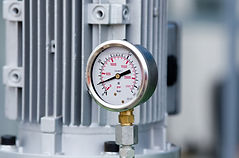Argon Gas & Argon Gas Blends for Welding
You Can Rely On Our Unique Lineup of Argon Gas and Argon Welding Gas Blends For MIG / TIG / Stainless Steel & Aluminum Welding
Our Unique Noble Mix Lineup of Argon-Mixed Gases
Argon, which has the symbol AR in the periodic table, is the most abundant noble gas in the Earth's crust, and is called a noble gas because it is so majestic that it doesn't react with anything. That’s why we have used Argon gas as the foundation for our range of innovative specialty welding gas mixtures, known as the Noble Mix.
Our Noble Mix of Argon gas and Argon gas mixed gases can be used in a range of welding applications for superior results. These welding gas mixtures are made up predominantly of Argon gas which has been mixed with either carbon dioxide or oxygen depending on your specific welding needs. We also provide a full range of welding supplies and safety equipment.

Our Noble Mix Gases Include...
NMAC15T
NMAC15T 85% Argon Gas and 15% Carbon Dioxide.
NMAC15T
NMAC15T
NMAC15T 85% Argon and 15% Carbon Dioxide.
NMAC15T
NMAC25T
NMAC25T 75% Argon Gas and 25% Carbon Dioxide.
NMAC25T 75% Argon and 25% Carbon Dioxide.
NMAC25T
NMACO2T
NMACO2T 98% Argon Gas and 2% Oxygen.
NMACO2T 98% Argon and 2% Oxygen.
NMACO2T
NMOC23T
NMOC23T 95% Argon Gas, 3% Oxygen, and 2% Carbon Dioxide.
NMOC23T 95% Argon, 3% Oxygen, and 2% Carbon Dioxide.
NMOC23T
If you are interested in learning the specific applications where our Noble Mix can help you realize superior results, contact the Simcoe Gases team of industrial gas experts today.
MIG Welding Argon Shielding Gas Basics
MIG (GMAW) welding with Argon gas shielding gas, or with Argon gas blends and a solid wire electrode, produces a clean, slag-free weld without the need to continually stop welding to replace the electrode, as in Stick welding. Increased productivity and reduced clean-up are just two of the benefits possible with this process.
The primary purpose of using Argon welding gas for shielding is to prevent exposure of the molten weld pool to oxygen nitrogen and hydrogen contained in the atmosphere. The reaction of these elements with the weld pool can create a variety of problems, including porosity (holes within the weld bead) and excessive spatter.
Different shielding gases containing Argon gas also play an important role in determining weld penetration profiles, arc stability, mechanical properties of the finished weld, the transfer process you use and more.
Choosing the Right Gas
Argon, Helium, Carbon Dioxide and Oxygen are the four most common shielding gases/mixtures used in MIG welding, with each providing unique benefits and drawbacks in any given application.
Carbon Dioxide (CO2) is the most common of the reactive gases used in MIG welding and the only one that can be used in its pure form without the addition of inert gas.
For many companies, including those that place an emphasis on weld quality, appearance and reducing post-weld clean-up, a mixture of between 75% and 95% percent Argon gas and 5% to 25% percent CO2 will provide a more desirable combination of arc stability, puddle control and reduced spatter than pure CO2. Argon gas also produces a narrower penetration profile, which is useful for fillet and butt welds. If you’re welding a non-ferrous metal — aluminum, magnesium or titanium — you’ll need to use 100 percent Argon welding gas.
Oxygen, also a reactive gas, can improve weld pool fluidity, penetration and arc stability in mild carbon, low alloy and stainless steel, oxygen mixes are typically in the amounts of 1 to 8 percent. Mixtures of 98 percent Argon gas / 2 percent oxygen and 92 percent Argon gas / 8 percent oxygen are common gas mixtures.
Helium, like pure Argon gas, is generally used with non-ferrous metals, but also with stainless steels. Because it produces a wide, deep penetration profile, Helium works well with thick materials and is usually used in ratios between 25% and 75% Helium to 75% and 25% percent Argon gas. Helium creates a ‘hotter’ arc, which allows for faster travel speeds and higher productivity rates. However, it is more expensive and requires a higher flow rate than Argon welding gas, so you’ll need to calculate the value of the productivity increase against the increased cost of the gas. With stainless steel, Helium is typically used in a tri-mix formula of Argon gas and CO2.
Choosing the right shielding gas for your specific application will require a careful analysis of the type of welding you are doing as well as your operational priorities. Using the guidelines above should provide a good start to the learning process, but be sure to consult your local welding supply distributor prior to making a final decision.
Argon Gas & Argon Gas Mixes FAQs










We provide regular delivery of Argon Gas, Argon Gas Mixes and Specialty Welding Gases to these areas and all points between…..
GTA
Toronto, GTA, Etobicoke, North York, Scarborough, Vaughan, Woodbridge, Concord, Thornhill, Markham, and more.
West
Mississauga, Brampton, Georgetown, Oakville, Burlington, Hamilton, Niagara Falls, Milton, Guelph, Cambridge, Kitchener, Waterloo, and more.
East
Pickering, Ajax, Whitby, Oshawa, and more.
North
Richmond Hill, Newmarket, Aurora, Bradford, Innisfil, Alliston, New Tecumseh, Orangeville, Caledon, Cookstown, Barrie, Orillia, Gravenhurst, Bracebridge, and more.
We can deliver all Gases, Dry Ice and Welding Supplies to anywhere else in Ontario as well, by special request. Please give us a call to discuss your needs.



